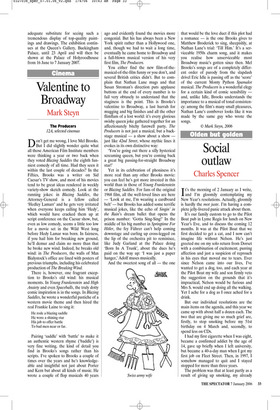Grand tour of Venice
Andrew Lambirth on the splendour of the Canaletto exhibition at the QueenŌĆÖs Gallery
Magnet for tourists as it is, Buckingham Palace is the perfect setting for Canaletto in Venice, an exhibition devoted to the grandest producer of tourist art of the 18th century focusing exclusively on a city which had already become one of the worldŌĆÖs leading tourist destinations. Giovanni Antonio Canal (1697ŌĆō1768) was known as Canaletto to distinguish him from his father, a successful painter of theatrical scenery. Young Giovanni trained in Venice in the family business, before branching out on his own in the early 1720s and painting views of Venice for the rich nobles undertaking the Grand Tour. As artists usually do, he needed an agent to promote and sell his work, and who better than Joseph Smith (c.1674ŌĆō1770), merchant banker, book dealer and publisher? Smith was a noted collector whose palazzo was an established port of call for Grand Tourists. He took orders for CanalettoŌĆÖs pictures, and himself built up an excellent collection of the VenetianŌĆÖs paintings and drawings, which was bought for George III in 1762. The current display is a selection from it.
We are offered an exhibition of 14 paintings and 70 drawings, which includes the largest group of works on paper by Canaletto ever shown in Britain. And if you remain unconvinced by his skilful contrivances in paint, the exquisite freshness of the drawings, their virtuoso handling and effortless control of light and atmosphere, will surely win you over. The show begins with an anteroom of drawings including a group of four beautiful compositional drafts in ink over pencil. The subject is firmly established, with a large map of Venice to help identify the views. Actually, Canaletto was not above ŌĆśimprovingŌĆÖ a composition through subtle manipulation or the editing of reality. Buildings were moved or eliminated, the fall of light altered to provide pictorial variety. He was making topographical views, certainly, but they never pretended to be ŌĆśwarts and allŌĆÖ. Canaletto is the master of the idealised view, often a composite, observed from multiple viewpoints and then fused into a harmonious new whole.
As the visitor enters the main gallery, the full splendour of the exhibition becomes apparent. At first glance, the sin gle file of a dozen same-sized paintings along the left-hand wall is enough to make you catch your breath. On the far-end wall hang two larger paintings, while the opposite long wall is given over to drawings. The walls have been clad in a vivid blue cloth, woven from wool from the Isle of Bute, which suits the drawings perfectly, and rather surprisingly sets off the paintings also to great advantage. The dozen paintings of the Grand Canal are full of the most marvellous details (like the woman in the tenth picture looking down from her balcony), all bathed in a clear, revealing light. ItŌĆÖs amazing how much variation Canaletto finds or creates within a fairly restricted range of subject. The first painting in this series, for instance, has an openness not generally present in these works. It looks towards the lagoon, and projects an uncluttered naturalism and charm. The third painting features passages of gorgeous faded pink brickwork, and is notable for the scaffolding on the roofs like TV aerials. In 1742, 15 years after it was painted, Canaletto added the balustrade and statue in front of the bell tower on the waterfront at mid-left.
In the seventh painting of the series, the scaffolding stands prosaically revealed as structures to air the washing, while the water of the canal is rendered in grey-bluegreen horizontal parallels, not the finicking curlicues Canaletto became known for. Look, for example, at the open parenthesis-shaped waves in the two larger paintings of the Regatta and the Ascension Day ceremony. The ruffled water is more stylised, the compositions more ornate, deliberate, more like set pieces. To our contemporary taste for the unfinished and fragmentary, it is perhaps the drawings which will appeal most. Canaletto was a stunning technician, capable of the most eloquent of pen squiggles. He could summon figures out of looped lines, or produce finished drawings of great intricacy which were intended as works in their own right. The fantastic, invented scenes (a type of drawing known as a capriccio), have a glorious freedom of invention. But the most seductive of all the drawings is a group of atmospheric views of the lagoon, an area of Venice still unfamiliar to tourists. In grey wash and brown ink, Canaletto conjures up the empty spaces to the east of the city, unfashionable views of mudflats punctuated by boats that were never made into paintings but exert a tremendous pull on the imagination.
By the 1740s, the tourist trade in Venice was in decline, and Canaletto decided he would have to go to his patrons if they no longer came to him. In May 1746 he arrived in London, and stayed in England for most of the next decade, painting the Thames and the country houses of the wealthy. (For an imaginative and enjoyable evocation of these years, see Janet LaurenceŌĆÖs novel Canaletto and the Case of Westminster Bridge.) He returned to Venice for his last decade, working almost to the end. This exhibition is accompanied by an elegant paperback catalogue, competitively priced at ┬Ż7.95, though there can be no adequate substitute for seeing such a tremendous display of top-quality paintings and drawings. The exhibition continues at the QueenŌĆÖs Gallery, Buckingham Palace, until 23 April and will then be shown at the Palace of Holyroodhouse from 16 June to 7 January 2007.






































 Previous page
Previous page